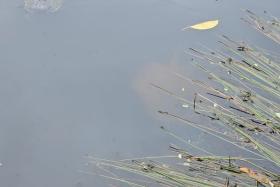More going to taxidermists to preserve pets
More pet owners turning to taxidermists to preserve their dogs, cats and tortoises
For pet lovers, one of their ultimate wishes is that their pets to be with them forever.
And thanks to Mr Ken Mar, that is now a reality.
Mr Mar, 57, is a taxidermist who helps owners preserve their pets after they die.
"Some of the pet owners, even the men, come to me with tears in their eyes because they love their pets so much and it hurts when the pets die," said Mr Mar, who has been a taxidermist for about 20 years and was behind the preservation of Sheba the polar bear from the Singapore Zoo after it died in 2012.
Taxidermy is the art of preparing, stuffing, and mounting the skins of animals with life-like effect.
The usual pets that he deals with include cats and dogs, while the more unusual ones include iguanas and even a hedgehog.
Mr Mar, who is among a handful of taxidermists here, said: "The taxidermy process can take several weeks, depending on the size of the animal and the humidity."
A small pet like a tortoise takes about two weeks, while others like cats and dogs take about eight weeks.
Depending on the animal, it can cost from $200 to preserve a small pet such as a guinea pig to about $2,500 for a bigger one like a golden retriever.
Mr Mar said demand for his services has grown. A few years ago, he would receive just three requests from clients to preserve their pets. Now, he gets around seven a month.
The rise in interest in pet taxidermy has prompted a duo here to start a company providing pet lovers access to expert taxidermists in South Africa.

Business partners Rebecca Ho, 30, and Donovan Kretsman, 31, plan to launch Anubis Pet SG early next year.
Mr Kretsman decided to learn how to preserve animals after his pet dog died in South Africa.
The services of these experts command a premium, starting from around $1,000 depending on the animal's size and pose that the owner wants their pet to be in.
So far the company has received inquiries and requests from about six pet owners regarding their taxidermy services.
Mr Mar, who learnt the art of taxidermy in New Zealand, said it takes a lot of patience and artistic inclination to do it right as it is an art form.
And it is his skill with preserving the likeness of the pets that have clients like Mr Vincent Ng coming to him.
Mr Ng said that when his eight-month-old tortoise, Ball, died about two weeks ago, it felt like a member of his own family had passed away.
The 26-year-old self-employed took it to Mr Mar to have it preserved.
Mr Ng, said: "This way, I can admire Ball every day.
"For me, it's a way of giving her a 'second chance' in life.".
HOW AN ANIMAL IS PRESERVED
- The animal is skinned using equipment such as scalpel, tweezer and shears. This process takes about four hours.
- The skin is soaked in vegetable tanning agents to convert it to leather. Depending on the size of the animal, it can take up to seven weeks for this part of the process to be completed. The animal's fur remains intact after this process.
- Measurements of the original body are then taken so that a new one can be made. The new body is made from materials such as foam or plastic and takes a week.
- Once the body is ready, industrial glue is used to attach the skin to the body.
- Other features, such as eyes, teeth, and claws are attached.
- The taxidermied animal is then left to dry for up to four days.
Get The New Paper on your phone with the free TNP app. Download from the Apple App Store or Google Play Store now



